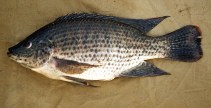http://www.fishbase.org/Summary/speciesSummary.php?genusname=Oreochromis&speciesname=jipe ---> http://192.134.151.83/Summary/speciesSummary.php?genusname=Oreochromis&speciesname=jipe
http://192.134.151.83/Summary/speciesSummary.php?genusname=Oreochromis&speciesname=jipe ---> https://fishbase.mnhn.fr/Summary/speciesSummary.php?genusname=Oreochromis&speciesname=jipe
https://fishbase.mnhn.fr/Summary/speciesSummary.php?genusname=Oreochromis&speciesname=jipe ---> https://fishbase.mnhn.fr/summary/Oreochromis-jipe.html
Oreochromis jipe, Jipe tilapia : fisheries, aquaculture

You can
sponsor
this page
Common name (e.g. trout)
Genus + Species (e.g. Gadus morhua)
-

-
About this page
-
Languages
-
User feedbacks
-
Citation
-
Uploads
-
Related species
-


 Jipe tilapia
Upload your
photos
and
videos
Jipe tilapia
Upload your
photos
and
videos
Pictures
|
Google image
 Oreochromis jipe
Oreochromis jipe
Picture by
de Vos, L.
Teleostei (teleosts) >
Cichliformes
(Cichlids, convict blennies) >
Cichlidae
(Cichlids) > Pseudocrenilabrinae
Etymology:
Oreochromis:
Latin, aurum = gold + Greek, chromis = a fish, perhaps a perch (Ref.
45335
)
.
Environment: milieu / climate zone / depth range / distribution range
Ecology
Freshwater; benthopelagic. Tropical
Africa: Pangani River in Kenya and Tanzania (Ref.
2
,
52331
,
118630
), from Lake Jipe down to the Pangani Falls dam (Ref.
118638
). Introduced in ponds at Korogwe (Ref.
2
), thence distributed to several ponds and dams in Tanzania (Ref.
2
,
54836
), including near Tanga (Ref.
2
), in the Usambara Mountains (Ref.
2
), in Lake Singida (Ref.
2
,
54836
), and in dams near Dodoma (Ref.
54836
).
Length at first maturity / Size / Weight / Age
Maturity: L
m
?
, range 20 - ? cm
Max length : 50.0 cm SL male/unsexed; (Ref.
2
)
Dorsal
spines
(total): 17 - 19;
Dorsal
soft rays
(total): 11-13;
Anal
spines
: 3-4;
Anal
soft rays
: 10 - 12;
Vertebrae
: 32 - 33. Diagnosis: A large bodied tilapia, with a slender body and small head and mouth; body depth 2.5-2.8 times in standard length (Ref.
4967
,
118638
). It can be distinguished by following characters: teeth of jaws with slender shafts in young, uniformly slender in adults; pharyngeal teeth very fine and crowded; dentigerous area with rounded lobes and short apex, its median length nearly always less than that of the blade; pectoral fin 34.3-41.2% of standard length, reaching base of anal fin; anal spines III-V (Ref.
2
,
55060
). Males and females are characterised by rows of blotched scales across the flanks; males have a pale blue head with dark spots, dark fins with pale spots, and orange margins to the dorsal and caudal; females and non-territorial males plainer and typically paler, and in some populations there is a more olive/yellow gular and ventral region (Ref.
118638
). Caudal fin long with very definite vertical black or dark brown stripes (Ref.
55060
).
Found in lakes and rivers (Ref.
4967
). Chiefly a browser of periphyton in the lake, but additionally feeding also on bottom deposits and associated phytobenthos (Ref.
30832
). A maternal mouthbrooder (Ref.
54046
,
55060
,
118638
). Occasionally territorial (Ref.
2
). It supports artisanal fisheries in lakes and dams across the Pangani catchment, with the largest fisheries in Lake Jipe and Nyumba ya Mungu (Ref.
118638
). IUCN conservation status is critically endangered due to its restricted range and evidence of declining stocks between the 1970s and 2000 (Ref.
118638
).
A maternal mouthbrooder (Ref.
54046
,
55060
,
118638
). Breeding pits consist of a central pit surrounded by two or three series of smaller pits (Ref.
2
,
55060
).
Trewavas, E.
, 1983. Tilapiine fishes of the genera
Sarotherodon
,
Oreochromis
and
Danakilia
. British Mus. Nat. Hist., London, UK. 583 p. (Ref.
2
)
IUCN Red List Status (Ref.
130435
)
Endangered (EN)
(B1ab(i,ii,iii)); Date assessed:
23 June 2022
CITES
Not Evaluated
Not Evaluated
Threat to humans
Harmless
Human uses
Fisheries: commercial; aquaculture: experimental
FAO - Publication:
search
|
FishSource
|
More information
Countries
FAO areas
Ecosystems
Occurrences
Introductions
Stocks
Ecology
Diet
Food items
Food consumption
Ration
Common names
Synonyms
Metabolism
Predators
Ecotoxicology
Reproduction
Maturity
Spawning
Spawning aggregation
Fecundity
Eggs
Egg development
Age/Size
Growth
Length-weight
Length-length
Length-frequencies
Morphometrics
Morphology
Larvae
Larval dynamics
Recruitment
Abundance
BRUVS
References
Aquaculture
Aquaculture profile
Strains
Genetics
Electrophoreses
Heritability
Diseases
Processing
Nutrients
Mass conversion
Collaborators
Pictures
Stamps, Coins Misc.
Sounds
Ciguatera
Speed
Swim. type
Gill area
Otoliths
Brains
Vision
Tools
E-book
|
Field guide
|
Length-frequency wizard
|
Life-history tool
|
Point map
|
Classification Tree
|
Catch-MSY
|
Special reports
Check for Aquarium maintenance
|
Check for Species Fact Sheets
|
Check for Aquaculture Fact Sheets
Download XML
Summary page
|
Point data
|
Common names
|
Photos
Internet sources
AFORO (otoliths) |
Aquatic Commons
|
BHL
|
Cloffa
|
BOLDSystems
|
Websites from users
|
Check FishWatcher
|
CISTI
|
Catalog of Fishes
:
genus
,
species
|
DiscoverLife
|
ECOTOX
| FAO - Publication:
search
|
Faunafri
| Fishipedia |
Fishtrace
| GenBank:
genome
,
nucleotide
|
GloBI
|
Google Books
|
Google Scholar
|
Google
| IGFA World Record |
MitoFish
|
Otolith Atlas of Taiwan Fishes
|
PubMed
| Reef Life Survey | Socotra Atlas |
Tree of Life
| Wikipedia:
Go
,
Search
| World Records Freshwater Fishing |
Zoological Record
Estimates based on models
Phylogenetic diversity index (Ref.
82804
): PD
50
= 0.5000 [Uniqueness, from 0.5 = low to 2.0 = high].
Bayesian length-weight: a=0.01905 (0.00827 - 0.04391), b=3.01 (2.82 - 3.20), in cm total length, based on LWR estimates for this (Sub)family-body shape (Ref.
93245
).
Trophic level (Ref.
69278
): 2.0 ±0.00 se; based on food items.
Resilience (Ref.
120179
): Medium, minimum population doubling time 1.4 - 4.4 years (Preliminary K or Fecundity.).
Fishing Vulnerability (Ref.
59153
): Moderate vulnerability (44 of 100).
Price category (Ref.
80766
):
Unknown
.
Back to Search
Random Species
Back to Top
Accessed through:
Not available
FishBase mirror site :
localhost
Page last modified by :
mrius-barile
- 20 July 2016
Fatal error
: Uncaught ArgumentCountError: Too few arguments to function checkEcotox(), 1 passed in /var/www/html/summary/speciessummary.php on line 2304 and exactly 3 expected in /var/www/html/includes/speciessummary.lib.php:2579 Stack trace: #0 /var/www/html/summary/speciessummary.php(2304): checkEcotox() #1 {main} thrown in
/var/www/html/includes/speciessummary.lib.php
on line
2579
|